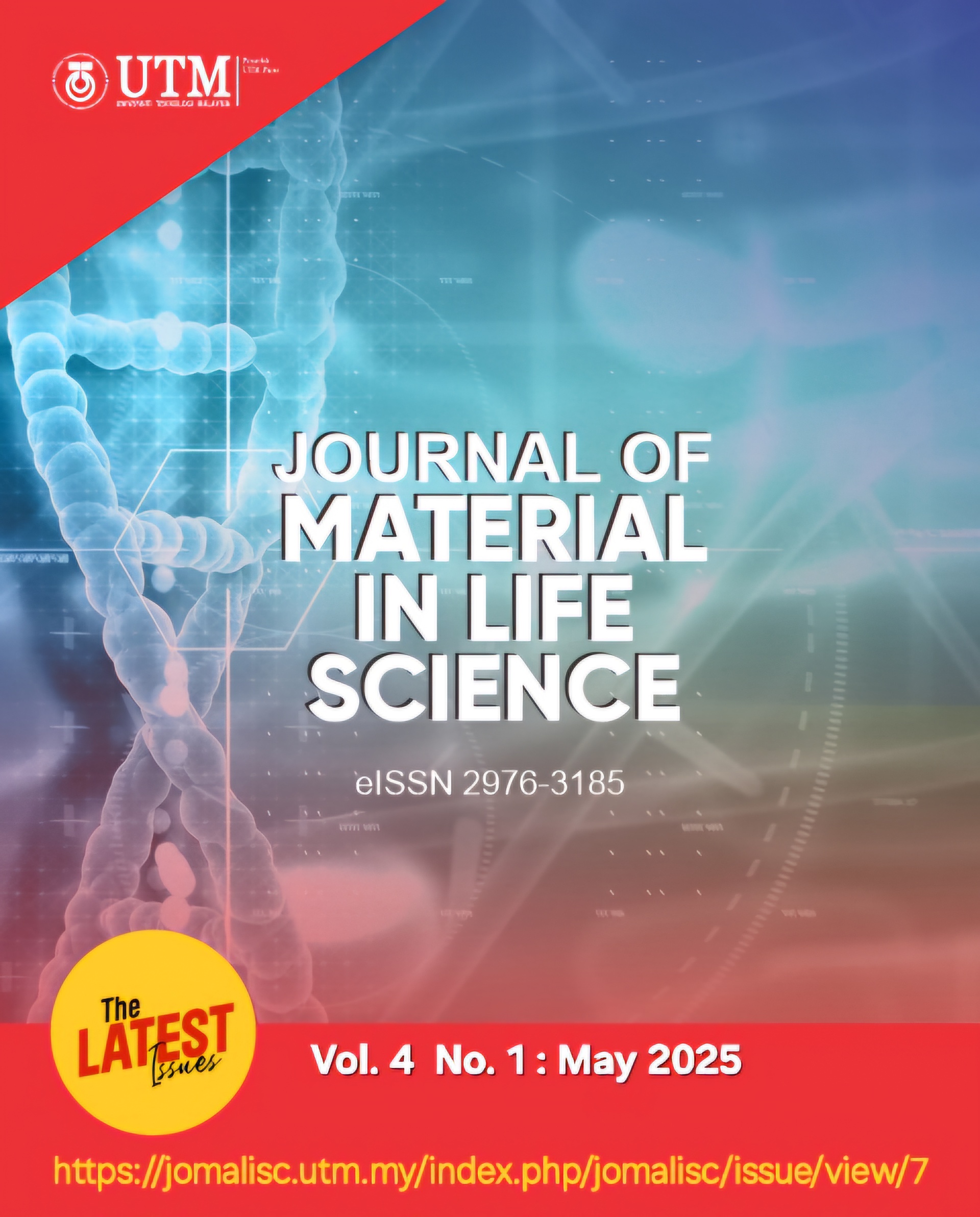Green Magnetic Adsorbent Functionalized with Humic Acid for Efficient Removal of Saxitoxin from Water
DOI:
https://doi.org/10.11113/jomalisc.v4.88Keywords:
adsorption, magnetized adsorbent, humic acid, paralytic shellfish toxin, saxitoxinAbstract
Water contamination by saxitoxin (STX), originating from harmful algal blooms intensified by anthropogenic eutrophication, poses a serious ecological and public health concern due to its potent neurotoxicity. This study developed a novel, eco-friendly magnetic humic acid-functionalized adsorbent (Fe3O4-HA) for STX removal from water. Fe3O4-HA was synthesized via co-precipitation, followed by humic acid (HA) functionalization. Successful synthesis was confirmed using Fourier-transform infrared spectroscopy, scanning electron microscopy with energy dispersive X-ray spectroscopy, and vibrating sample magnetometry, revealing the presence of key functional groups, heterogeneous morphology, elemental composition (C, O, Fe), and paramagnetic properties (23.385 emu/g). The point of zero charge (pH 2.5) indicated the surface neutrality threshold. Batch adsorption parameters—solution pH, adsorbent dosage, contact time, and STX concentration—were optimized. Maximum STX removal (71.04%) occurred at natural solution pH (7.94) using 30 mg adsorbent, within 8 min, at an initial STX concentration of 100 µg/L. Kinetic analyses demonstrated the adsorption followed a pseudo-second-order model (R² = 0.9983), indicating chemisorption as the dominant mechanism. Multiple interactions—including electrostatic attraction, hydrogen bonding, and π-π interactions between negatively charged functional groups in HA and STX—were proposed. An analytical eco-scale evaluation yielded a score of 81, classifying the synthesis as environmentally friendly. Comparison with existing methods confirmed that Fe3O4-HA offers superior adsorption efficiency, rapid action, and eco-sustainability. Thus, Fe3O4-HA represents a promising adsorbent for practical environmental remediation of STX-contaminated waters, warranting further studies for real-world scalability and applicability.
Keywords adsorption, magnetized adsorbent, humic acid, paralytic shellfish toxin, saxitoxin
References
Abbas, Z. M. A., Shatti, W. A., Mohammad, A. M., & Khodair, Z. T. (2024). Magnetic iron oxide: Preparation and characterization for antibacterial activity applications. Journal of Sol-Gel Science and Technology, 109(2), 534–542. https://doi.org/10.1007/s10971-023-06300-w
Ahmad Wani, A., Shahadat, M., Wazed Ali, S., Ziauddin Ahammad, S., & Kashif Uddin, M. (2022). Recent advances and future perspectives of polymer-based magnetic nanomaterials for detection and removal of radionuclides: A review. Journal of Molecular Liquids, 365, 119976. https://doi.org/10.1016/j.molliq.2022.119976
Amirmahani, N., Mahdizadeh, H., Malakootian, M., Pardakhty, A., & Mahmoodi, N. O. (2020). Evaluating nanoparticles decorated on Fe₃O₄@SiO₂-Schiff base (Fe₃O₄@SiO₂-APTMS-HBA) in adsorption of ciprofloxacin from aqueous environments. Journal of Inorganic and Organometallic Polymers and Materials, 30(9), 3540–3551. https://doi.org/10.1007/s10904-020-01499-5
Anderson, C. R., Berdalet, E., Kudela, R. M., Cusack, C. K., Silke, J., O’Rourke, E., Dugan, D., McCammon, M., Newton, J. A., Moore, S. K., Paige, K., Ruberg, S., Morrison, J. R., Kirkpatrick, B., Hubbard, K., & Morell, J. (2019). Scaling up from regional case studies to a global harmful algal bloom observing system [Review]. Frontiers in Marine Science, 6, 250. https://doi.org/10.3389/fmars.2019.00250
Ba-Abbad, M. M., Benamour, A., Ewis, D., Mohammad, A. W., & Mahmoudi, E. (2022). Synthesis of Fe₃O₄ nanoparticles with different shapes through a co-precipitation method and their application. JOM, 74(9), 3531–3539. https://doi.org/10.1007/s11837-022-05380-3
Chambers, C., Grimes, S., Fire, S., & Reza, M. T. (2024). Influence of biochar on the removal of Microcystin-LR and saxitoxin from aqueous solutions. Scientific Reports, 14(1), 11058. https://doi.org/10.1038/s41598-024-61802-z
Fernández-Delgado, M., López-Linares, J. C., Lucas, S., García-Cubero, M. T., & Coca, M. (2023). Efficient recovery and characterization of humic acids from municipal and manure composts: A comparative study. Waste Management, 172, 245–255. https://doi.org/10.1016/j.wasman.2023.10.025
Fu, X., Sarker, S., Ma, W., Zhao, W., Rong, Y., & Liu, Q. (2023). Novel phenylalanine-modified magnetic ferroferric oxide nanoparticles for ciprofloxacin removal from aqueous solution. Journal of Colloid and Interface Science, 632, 345–356. https://doi.org/10.1016/j.jcis.2022.11.067
Gago-Martínez, A., Moscoso, S. A., Leão Martins, J. M., Rodriguez Vázquez, J.-A., Niedzwiadek, B., & Lawrence, J. F. (2001). Effect of pH on the oxidation of paralytic shellfish poisoning toxins for analysis by liquid chromatography. Journal of Chromatography A, 905(1), 351–357. https://doi.org/10.1016/S0021-9673(00)00963-8
Kang, S., Yi, B., Nie, X., Wan, Q., & Yang, H. (2024). Boosting adsorption of ciprofloxacin on Fe₃O₄ nanoparticles modified sepiolite composite synthesized via a vacuum-filtration assisted coprecipitation strategy. Journal of Water Process Engineering, 66, 106038. https://doi.org/10.1016/j.jwpe.2024.106038
Keshta, B. E., Gemeay, A. H., Sinha, D. K., Elsharkawy, S., Hassan, F., Rai, N., & Arora, C. (2024). State of the art on the magnetic iron oxide nanoparticles: Synthesis, functionalization, and applications in wastewater treatment. Results in Chemistry, 7, 101388. https://doi.org/10.1016/j.rechem.2024.101388
Kulabhusan, P. K., & Campbell, K. (2024). Physico-chemical treatments for the removal of cyanotoxins from drinking water: Current challenges and future trends. Science of the Total Environment, 917, 170078. https://doi.org/10.1016/j.scitotenv.2024.170078
Kumar, P., Hegde, K., Brar, S. K., Cledon, M., & Pour, A. K. (2018). Physico-chemical treatment for the degradation of cyanotoxins with emphasis on drinking water treatment—How far have we come? Journal of Environmental Chemical Engineering, 6(4), 5369–5388. https://doi.org/10.1016/j.jece.2018.08.032
Le Moal, M., Gascuel-Odoux, C., Ménesguen, A., Souchon, Y., Étrillard, C., Levain, A., ... & Pinay, G. (2019). Eutrophication: A new wine in an old bottle? Science of the Total Environment, 651, 1–11. https://doi.org/10.1016/j.scitotenv.2018.09.139
Lorons, D., Jafar-Sidik, M., Ali, N., Mohamad-Azaini, F., Rodrigues, K. F., & Chin, G. J. W. L. (2022). The variation of environmental profiles during harmful algal bloom in Sepanggar Bay, Sabah, Malaysia. Journal of Oceanography, 78(2), 121–132. https://doi.org/10.1007/s10872-022-00634-9
María de Lourdes, A., Sergio, G.-R., & Guillermo, T.-I. (2022). Mechanisms of action of humic substances as growth promoters in animals. In M. Abdelhadi (Ed.), Humus and Humic Substances (Ch. 2). IntechOpen. https://doi.org/10.5772/intechopen.105956
Melegari, S. P., & Matias, W. G. (2012). Preliminary assessment of the performance of oyster shells and chitin materials as adsorbents in the removal of saxitoxin in aqueous solutions. Chemistry Central Journal, 6(1), Article 86. https://doi.org/10.1186/1752-153X-6-86
Nazari, M. T., Schnorr, C., Rigueto, C. V. T., Alessandretti, I., Melara, F., da Silva, N. F., Crestani, L., Ferrari, V., Vieillard, J., Dotto, G. L., Silva, L. F. O., & Piccin, J. S. (2022). A review of the main methods for composite adsorbents characterization. Environmental Science and Pollution Research, 29(59), 88488–88506. https://doi.org/10.1007/s11356-022-23883-z
Ng, N., Abdul Keyon, A. S., Wan Ibrahim, W. A., Sanagi, M. M., Sutirman, Z. A., & Mohd Marsin, F. (2023). Amino-functionalised chrysin as adsorbent in dispersive micro-solid phase extraction of selected heavy metal ions from stingless bee honey. Journal of Food Composition and Analysis, 123, 105561. https://doi.org/10.1016/j.jfca.2023.105561
Nguyen, M. D., Tran, H.-V., Xu, S., & Lee, T. R. (2021). Fe₃O₄ nanoparticles: Structures, synthesis, magnetic properties, surface functionalization, and emerging applications. Applied Sciences, 11(23), 11301. https://www.mdpi.com/2076-3417/11/23/11301
Olano, D. E. B., Salvador-Reyes, L. A., Montaño, M. N. E., & Azanza, R. V. (2020). Sorption of paralytic shellfish toxins (PSTs) in algal polysaccharide gels. Algal Research, 45, 101655. https://doi.org/10.1016/j.algal.2019.101655
Pillai, S. B. (2020). Adsorption in water and used water purification. In J. Lahnsteiner (Ed.), Handbook of Water and Used Water Purification (pp. 1–22). Springer. https://doi.org/10.1007/978-3-319-66382-1_4-1
Pini, R., Siderius, D. W., & Siepmann, J. I. (2022). Preface to adsorption and diffusion in porous materials special issue: Equilibrium adsorption data for energy and environmental applications. Journal of Chemical & Engineering Data, 67(7), 1597–1598. https://doi.org/10.1021/acs.jced.2c00382
Popa, S., Radulescu-Grad, M. E., Perdivara, A., & Mosoarca, G. (2021). Aspects regarding colour fastness and adsorption studies of a new azo-stilbene dye for acrylic resins. Scientific Reports, 11(1), 5889. https://doi.org/10.1038/s41598-021-85452-7
Pormazar, S. M., Ehrampoush, M. H., Ghaneian, M. T., Khoobi, M., Talebi, P., & Dalvand, A. (2020). Application of amine-functioned Fe₃O₄ nanoparticles with HPEI for effective humic acid removal from aqueous solution: Modeling and optimization. Korean Journal of Chemical Engineering, 37(1), 93–104. https://doi.org/10.1007/s11814-019-0411-y
Rápó, E., & Tonk, S. (2021). Factors affecting synthetic dye adsorption; desorption studies: A review of results from the last five years (2017–2021). Molecules, 26(17), 5419. https://www.mdpi.com/1420-3049/26/17/5419
Revellame, E. D., Fortela, D. L., Sharp, W., Hernandez, R., & Zappi, M. E. (2020). Adsorption kinetic modeling using pseudo-first order and pseudo-second order rate laws: A review. Cleaner Engineering and Technology, 1, 100032. https://doi.org/10.1016/j.clet.2020.100032
Santosa, S. J., Krisbiantoro, P. A., Yuniarti, M., Kustomo, & Koesnarpardi, S. (2021). Magnetically separable humic acid-functionalized magnetite for reductive adsorption of tetrachloroaurate(III) ion in aqueous solution. Environmental Nanotechnology, Monitoring & Management, 15, 100454. https://doi.org/10.1016/j.enmm.2021.100454
Sayed, N. S. M., Ahmed, A. S. A., Abdallah, M. H., & Gouda, G. A. (2024). ZnO@ activated carbon derived from wood sawdust as adsorbent for removal of methyl red and methyl orange from aqueous solutions. Scientific Reports, 14(1), 5384. https://doi.org/10.1038/s41598-024-55158-7
Shen, Z., Kuang, Y., Zhou, S., Zheng, J., & Ouyang, G. (2023). Preparation of magnetic adsorbent and its adsorption removal of pollutants: An overview. TrAC Trends in Analytical Chemistry, 167, 117241. https://doi.org/10.1016/j.trac.2023.117241
Shi, H., Ding, J., Timmons, T., & Adams, C. (2012). pH effects on the adsorption of saxitoxin by powdered activated carbon. Harmful Algae, 19, 61–67. https://doi.org/10.1016/j.hal.2012.05.008
Silva, R. A., Park, J., Lee, E., Park, J., Choi, S. Q., & Kim, H. (2015). Influence of bacterial adhesion on copper extraction from printed circuit boards. Separation and Purification Technology, 143, 169–176.
Svobodová, E., Tišler, Z., Peroutková, K., Strejcová, K., Abrham, J., Šimek, J., Gholami, Z., & Vakili, M. (2024). Adsorption of Cu(II) and Ni(II) from aqueous solutions using synthesized alkali-activated foamed zeolite adsorbent: Isotherm, kinetic, and regeneration study. Molecules, 29(10), 2357. https://www.mdpi.com/1420-3049/29/10/2357
Townhill, B. L., Tinker, J., Jones, M., Pitois, S., Creach, V., Simpson, S. D., ... & Pinnegar, J. K. (2018). Harmful algal blooms and climate change: Exploring future distribution changes. ICES Journal of Marine Science, 75(6), 1882–1893. https://doi.org/10.1093/icesjms/fsy113
Tran, H. N. (2023). Adsorption technology for water and wastewater treatments. Water, 15(15), 2857. https://www.mdpi.com/2073-4441/15/15/2857
Wang, T., Fernandes, S. P. S., Araújo, J., Li, X., Salonen, L. M., & Espiña, B. (2023). A carboxyl-functionalized covalent organic polymer for the efficient adsorption of saxitoxin. Journal of Hazardous Materials, 452, 131247. https://doi.org/10.1016/j.jhazmat.2023.131247
Zhang, Y., Whalen, J. K., Cai, C., Shan, K., & Zhou, H. (2023). Harmful cyanobacteria–diatom/dinoflagellate blooms and their cyanotoxins in freshwaters: A nonnegligible chronic health and ecological hazard. Water Research, 233, 119807. https://doi.org/10.1016/j.watres.2023.119807


















